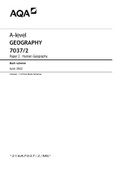Exam (elaborations)
AQA A-level GEOGRAPHY 7037/2 Paper 2 Human Geography Mark scheme June 2022 Version: 1.0 Final Mark Scheme .
- Course
- Institution
AQA A-level GEOGRAPHY 7037/2 Paper 2 Human Geography Mark scheme June 2022 Version: 1.0 Final Mark Scheme. MARK SCHEME – A-LEVEL GEOGRAPHY – 7037/2 – JUNE 2022 2 Mark schemes are prepared by the Lead Assessment Writer and considered, together with the relevant questions, by a panel of sub...
[Show more]



